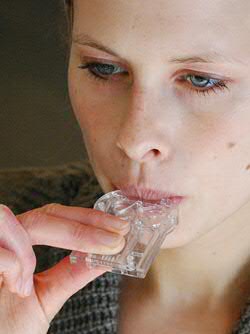Better ways to inhale drugs

Inhalation is an important method for administering drugs to patients with conditions such as asthma or cystic fibrosis. Anne Lexmond studied ways of adapting the drug and the type of inhaler so that they would be better suited to each other and to the patient. Her findings dovetail with demand from clinical practice. She will be awarded a PhD by the University of Groningen on 5 December 2014.
The Department of Pharmaceutical Technology and Biopharmacy of the UMCG/University of Groningen, where Anne Lexmond conducted her research, has plenty of experience in developing inhalers and drugs for inhalation. Two models developed there, the Novolizer and the Genuair, are already in widespread use. An inexpensive disposable inhaler, the Twincer, is in the final stages of development.
Fast
‘In four years’ time, this research into medicinal inhalers has answered a clinical demand from the UMCG and turned it into a new test. This is fast,’ explains pharmaceutical technologist Lexmond. The demand was for a test that could be used in research into new drugs for treating asthma. To carry out this test, patients undergo a controlled asthma attack, which is induced using a substance called adenosine. ‘The adenosine is inhaled via a nebulizer, but the concentration needed is so high that it affects the size of the drops that are inhaled. What’s more, it takes quite a long time to get the right dose into the lungs’, continues Lexmond.
Instead of dissolving and nebulizing the adenosine, Lexmond used a powder inhaler rather like the Twincer, which was specially developed for this research. The inhaler enabled researchers to get high doses of adenosine into the test subjects’ lungs. ‘It halved the time needed to administer the dose, which was less distressing for the patients undergoing the test.’
Children
As well as developing this new test, Lexmond also worked on a better inhaler for children. ‘At the moment, they use inhalers developed for adults.’ She conducted measurements on children to work out the criteria for a children’s inhaler. ‘Children have a smaller lung volume and inhale less powerfully and for a shorter time. The dose for children must be dispersed in half a litre of air, whereas normal volumes for adults can be as much as one-and-a-half litres.’
Cystic fibrosis
It is not only important to give the right dose when treating asthma, but also when administering antibiotics into the lungs of children with cystic fibrosis. ‘At present, this is administered via a nebulizer too, which takes quite a long time. And the drugs must be given twice a day.’ A powder inhaler would be much faster and more accurate. ‘A study is currently being carried out with cystic fibrosis patients’, adds Lexmond.
Tailor
‘The best thing would be to tailor the drugs and inhaler to suit each individual patient’, concludes Lexmond. This is not currently standard procedure. ‘But the method we developed at the University of Groningen has attracted a lot of interest,’ she continues.
Her PhD research earned her an exclusive grant to conduct pharmaceutical research at King’s College London. ‘Only two of these grants are awarded each year,’ says Lexmond, who has now moved to London. ‘A local-based company for pharmaceutical contract research has already expressed interest in using the test that we developed in Groningen, for example.’
Vaccination
A powder inhaler can also be used for administering vaccinations. ‘This has generated a lot of interest, as it means no more needles. However, the vaccine and the inhaler must be developed simultaneously, and the inhaler must not be too expensive. The Twincer would be a good option.’ Her colleague Wouter Tonnis, who will be awarded a PhD on the same day as Lexmond, was responsible for developing a vaccine for inhalation. His research into an inhalable vaccine for bird flu was widely reported in the media two weeks ago.
More information
- Anne Lexmond (1985) studied Pharmacy at the University of Groningen, where she also conducted her PhD research in the Groningen Research Institute of Pharmacy, department Pharmaceutical Technology and Biopharmacy. The title of her thesis is Technology in practice - The importance of matching purpose, patient, and product in pulmonary aerosol delivery. Her promotor is prof.dr. Erik Frijlink. Her current work is as a postdoc at the King’s College in London.
| Last modified: | 19 March 2020 1.39 p.m. |
More news
-
18 April 2024
PET-scan expert Jan Pruim benoemd tot Officier in Orde van Oranje Nassau
Hoogleraar medische beeldvorming Jan Pruim is bij zijn afscheid van het UMCG benoemd tot Officier in de Orde van Oranje Nassau. De koninklijke versierselen werden hem op woensdag 17 april uitgereikt door burgemeester Koen Schuiling van de gemeente...
-
15 April 2024
Single-molecule engineering niche in Gravitation research
With her expertise in single-molecule techniques, Dr. Kasia Tych (GBB) will contribute to a big Grvitation-research programme
-
15 April 2024
Night vision with artificial atoms
Every two weeks, UG Makers puts the spotlight on a researcher who has created something tangible, ranging from homemade measuring equipment for academic research to small or larger products that can change our daily lives. That is how UG...
